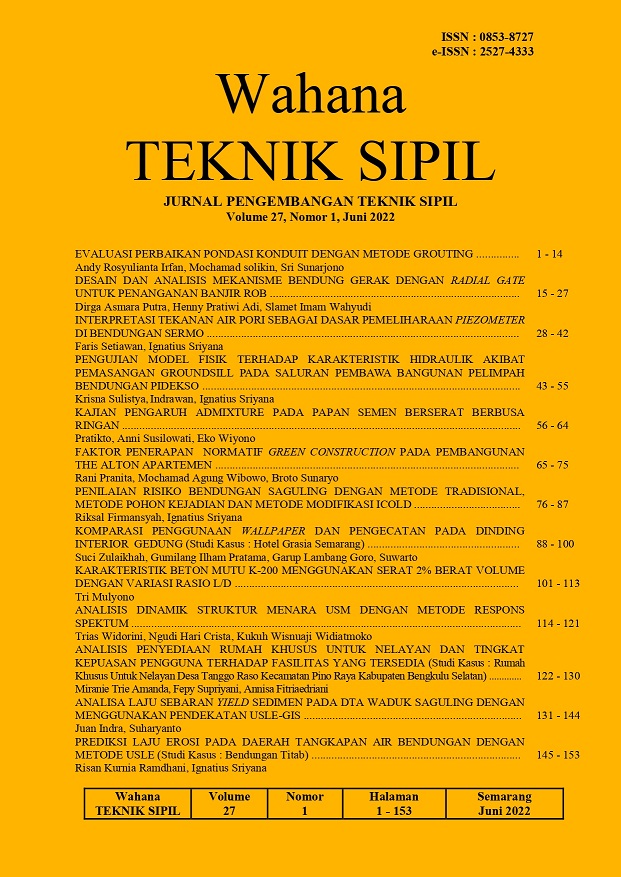PENGUJIAN MODEL FISIK TERHADAP KARAKTERISTIK HIDRAULIK AKIBAT PEMASANGAN GROUNDSILL PADA SALURAN PEMBAWA BANGUNAN PELIMPAH BENDUNGAN PIDEKSO
DOI:
https://doi.org/10.32497/wahanats.v27i1.3670Keywords:
physical hydraulic model test, Spillway, carrier channel, groundsill, scouringAbstract
Pidekso Dam is located in Pidekso Village, Wonogiri Regency, Central Java Province. The Pidekso Dam Spillway Building mode test was carried out to verify any deficiencies or design errors that might occur. One of the scope works in spillway model is a carrier channel downstream of the spillway which is 360 m long. To overcome the scour that occurs in the carrier channel downstream of the spillway, in the 4th series test, a groundsill structure was installed as a basic stabilizer for the carrier channel. The method is used in modelling include physical modelling, drainage testing, and observation of water flow and scouring that occurs at the bottom of the channel. The carrier channel groove model and the groundsill structure are made with a 1:40 scale both upright and flat (without distortion). The model test shows that the water flow in the carrier channel upstream of the groundsill is even and uniform with the bottom material of the channel not moving. At the bottom of the channel on the outer side of the bend which is assumed to be granular material, it is scoured to a depth of 2.68 m on the Z9 profile. This profile needs to be protected by rip-rap of concrete blocks, unless the base of the existing channel is a hard bedrock.References
Breusers. H.N.C. and Raudkivi. A.J., 1991), Scouring. IAHR Hydraulic Structure Design Manual. Rotterdam : AA Balkema.
Chow, Ven Te., 1997, Hidrolika Saluran Terbuka. Penerbit Erlangga.
Junaidi, F.F., 2014, Analisis Distribusi Kecepatan Aliran Sungai Musi (Ruas Jembatan Ampera Sampai dengan Pulau Kemaro). Jurnal Teknik Sipil dan Lingkungan Volume 2, No.3, hal. 542-552.
Lufira, R.D., Marsudi, S., 2015, Analisa Uji Model Fisik Pelimpah Bendungan Sukahurip di Kabupaten Pangandaran Jawa Barat. Jurnal Teknik Pengairan, volume 6, No. 1, Mei 2015, hal. 14- 21.
Purwantoro, D., 2015, Model Pengendalian Gerusan di Sekitar Abutmen dengan Pemasangan Groundsill dan Abutmen Bersayap. INERSIA, volume XI No.1 hal. 79-89.
Ragilia, S.P., Susarman, 2021, Efektifitas Struktur Groundsill dalam Mengurangi Gerusan di Dasar Sungai: Kajian Literatur. Journal of Infrastructural in Civil Engineering (JICE), volume 02, No. 1, hal. 8-15.
Raju., K.G.R., 1986, Aliran Melalui Saluran Terbuka. Jakarta : Erlangga.
Sarwono, Kirno, 2014, Penyempurnaan Desain Bangunan Pelimpang Cileuweung Dengan Uji Model Hidrolik Fisik. Jurnal Teknik Hidraulik, volume 5, No. 2, hal. 139-150.
SNI: 3965, 2008, Pembuatan Model Fisik Sungai dengan Dasar Tetap. Jakarta: Badan Standarisasi Nasional.
Zulfan, J., 2017, Optimasi Hidraulik Penanganan Gerusan di Hilir Bendung (Studi Kasus: Bendung Rengrang, Jawa Barat). Jurnal Teknik Hidraulik, volume 8, Juni 2017, hal. 15- 28.
Zulhusni, F.A., C. Ikhsan, Suyanto, 2017, Analisis Distribusi Kecepatan Aliran Pada Daerah Sudetan Wonosari Sungai Bengawan Solo. e-Jurnal MATRIKS TEKNIK SIPIL, hal. 368-376.
Downloads
Published
Issue
Section
License
Authors who publish with this journal agree to the following terms:Authors retain copyright and grant the journal right of first publication with the work simultaneously licensed under a Creative Commons Attribution License that allows others to share the work with an acknowledgement of the work's authorship and initial publication in this journal.
Authors are able to enter into separate, additional contractual arrangements for the non-exclusive distribution of the journal's published version of the work (e.g., post it to an institutional repository or publish it in a book), with an acknowledgement of its initial publication in this journal.
Authors are permitted and encouraged to post their work online (e.g., in institutional repositories or on their website) prior to and during the submission process, as it can lead to productive exchanges, as well as earlier and greater citation of published work (See The Effect of Open Access).






